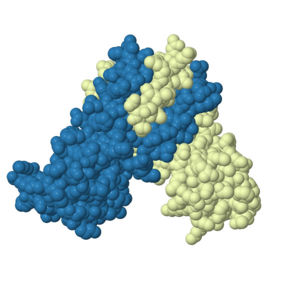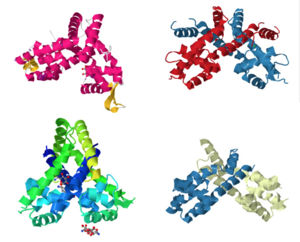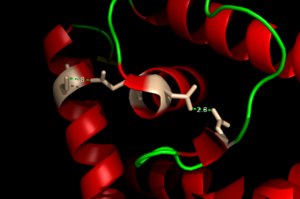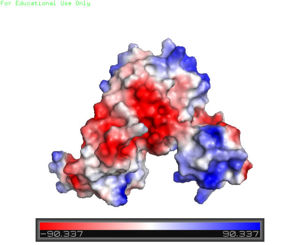Sandbox Reserved 1063
From Proteopedia
(Difference between revisions)
| Line 10: | Line 10: | ||
== '''DNA Binding''' == | == '''DNA Binding''' == | ||
| - | === Hydrogen Bond Network === | ||
| - | [[Image:H Bonding of DNA.png|300 px|left|thumb|The Hydrogen Bonding Network is shown with dotted green lines approximately 2.8 angstroms between residues. The network consists of 4 major residues as follows from right to left: E24, N38, Q40, S74. ]] | ||
| - | The binding of Zinc allows for the conformational change that induces the binding of DNA in order to activate genes. The binding of Zinc metals creates a hydrogen bond network within the protein that connects the metal binding sites and the [https://en.wikipedia.org/wiki/DNA-binding_domain DNA binding domain]. More importantly, the hydrogen bonding network connects the metal binding pockets to the alpha 4 helix. Alpha 4 helix on each monomer plays a crucial role in binding DNA because it acts as the recognition helix. <scene name='69/694230/Recognition_helix/1'>Specific residues</scene> in the recognition helix recognize a sequence of DNA that is unknown at the moment; however, scientists do know that the hydrogen bond network acts as an allosteric activator for the protein to bind DNA. The hydrogen bond network connects the alpha 2 and alpha 4 helix via hydrogen bonding between specific residues. After zinc is bound, a glutamate (<font color='blue'>E24</font>) residue from a random coil accepts a hydrogen bond from the carboxamide end of an asparagine (<font color='green'>N38</font>) residue from the alpha 2 helix. Then, a glutamine (<font color='gold'>Q40</font>) residue from alpha 2 helix accepts a hydrogen bond from a serine (<font color='red'>S74</font>) residue from the alpha 4 helix <ref>PMID:22085181</ref>. The color coding in the previous sentence represents the <scene name='69/694230/Hydrogen_bonding_1/1'>Hydrogen Bonding Network</scene> (<scene name='69/694230/Hydrogen_bonding_2/1'>Hydrogen Bonding Network with measurements</scene>), which is seen across the MarR family as a whole. | ||
| - | [[Image:Charge_map.jpg |300 px|right|thumb| A charge map of AdcR shows the general triangular shape and the positive charged (blue) area on HTH domains]] | ||
| - | |||
=== Helix-Turn-Helix Domain === | === Helix-Turn-Helix Domain === | ||
The AdcR MarR transcriptional regulator's structure resembles the other proteins in the same family as mentioned before; however, the most notable differences are found in the winged helix-turn-helix (wHTH) motif that assists in binding DNA. The major groove of DNA is bound to the recognition helix while the wings grip onto the minor grooves of DNA <ref>PMID:22085181</ref>. The charge map on the right highlights the <font color='blue'>positively</font> charged areas, which stabilize the negatively charged backbone of DNA. Although AdcR is a highly alpha helical protein, the "wings" of the DNA binding domain consist of two anti parallel beta strands that are made up of several positively charged residues. There is a wHTH domain on each monomer of the protein. | The AdcR MarR transcriptional regulator's structure resembles the other proteins in the same family as mentioned before; however, the most notable differences are found in the winged helix-turn-helix (wHTH) motif that assists in binding DNA. The major groove of DNA is bound to the recognition helix while the wings grip onto the minor grooves of DNA <ref>PMID:22085181</ref>. The charge map on the right highlights the <font color='blue'>positively</font> charged areas, which stabilize the negatively charged backbone of DNA. Although AdcR is a highly alpha helical protein, the "wings" of the DNA binding domain consist of two anti parallel beta strands that are made up of several positively charged residues. There is a wHTH domain on each monomer of the protein. | ||
The <scene name='69/694230/Whth_2/1'>winged helix-turn-helix</scene> domain is made up of the <font color='deep sky blue'>alpha 2</font> and <font color='deep sky blue'>alpha 4 helices</font> along with <font color='deep sky blue'>anti-parallel beta sheets</font> on each side. Only one monomer is shown. The recognition helix, or the alpha 4 helix, binds the major groove of DNA through hydrogen bonding and Van der Waals interactions between exposed bases. The wings of the helix bind the minor groove of DNA while the other helices stabilize the DNA and Protein upon binding. The two anti parallel beta sheets contain several <scene name='69/694230/Positive_residues_on_wing/1'>Arginine, Asparagine, and Lysine residues</scene> that stabilize this interaction between DNA. | The <scene name='69/694230/Whth_2/1'>winged helix-turn-helix</scene> domain is made up of the <font color='deep sky blue'>alpha 2</font> and <font color='deep sky blue'>alpha 4 helices</font> along with <font color='deep sky blue'>anti-parallel beta sheets</font> on each side. Only one monomer is shown. The recognition helix, or the alpha 4 helix, binds the major groove of DNA through hydrogen bonding and Van der Waals interactions between exposed bases. The wings of the helix bind the minor groove of DNA while the other helices stabilize the DNA and Protein upon binding. The two anti parallel beta sheets contain several <scene name='69/694230/Positive_residues_on_wing/1'>Arginine, Asparagine, and Lysine residues</scene> that stabilize this interaction between DNA. | ||
| + | |||
| + | === Hydrogen Bond Network === | ||
| + | [[Image:H Bonding of DNA.png|300 px|left|thumb|The Hydrogen Bonding Network is shown with dotted green lines approximately 2.8 angstroms between residues. The network consists of 4 major residues as follows from right to left: E24, N38, Q40, S74. ]] | ||
| + | The binding of Zinc allows for the conformational change that induces the binding of DNA in order to activate genes. The binding of Zinc metals creates a hydrogen bond network within the protein that connects the metal binding sites and the [https://en.wikipedia.org/wiki/DNA-binding_domain DNA binding domain]. More importantly, the hydrogen bonding network connects the metal binding pockets to the alpha 4 helix. Alpha 4 helix on each monomer plays a crucial role in binding DNA because it acts as the recognition helix. <scene name='69/694230/Recognition_helix/1'>Specific residues</scene> in the recognition helix recognize a sequence of DNA that is unknown at the moment; however, scientists do know that the hydrogen bond network acts as an allosteric activator for the protein to bind DNA. The hydrogen bond network connects the alpha 2 and alpha 4 helix via hydrogen bonding between specific residues. After zinc is bound, a glutamate (<font color='blue'>E24</font>) residue from a random coil accepts a hydrogen bond from the carboxamide end of an asparagine (<font color='green'>N38</font>) residue from the alpha 2 helix. Then, a glutamine (<font color='gold'>Q40</font>) residue from alpha 2 helix accepts a hydrogen bond from a serine (<font color='red'>S74</font>) residue from the alpha 4 helix <ref>PMID:22085181</ref>. The color coding in the previous sentence represents the <scene name='69/694230/Hydrogen_bonding_1/1'>Hydrogen Bonding Network</scene> (<scene name='69/694230/Hydrogen_bonding_2/1'>Hydrogen Bonding Network with measurements</scene>), which is seen across the MarR family as a whole. | ||
| + | [[Image:Charge_map.jpg |300 px|right|thumb| A charge map of AdcR shows the general triangular shape and the positive charged (blue) area on HTH domains]] | ||
== '''Zn(II) Binding''' == | == '''Zn(II) Binding''' == | ||
Revision as of 18:43, 14 April 2017
Adhesin Competence Regulator
| |||||||||||
References
- ↑ Sanson M, Makthal N, Flores AR, Olsen RJ, Musser JM, Kumaraswami M. Adhesin competence repressor (AdcR) from Streptococcus pyogenes controls adaptive responses to zinc limitation and contributes to virulence. Nucleic Acids Res. 2015 Jan;43(1):418-32. doi: 10.1093/nar/gku1304. Epub 2014 Dec, 15. PMID:25510500 doi:http://dx.doi.org/10.1093/nar/gku1304
- ↑ Guerra AJ, Dann CE, Giedroc DP. Crystal Structure of the Zinc-Dependent MarR Family Transcriptional Regulator AdcR in the Zn(II)-Bound State. J Am Chem Soc. 2011 Nov 21. PMID:22085181 doi:10.1021/ja2080532
- ↑ Fraústo da Silva J, Williams R. The Biological Chemistry of Elements: The Inorganic Chemistry of Life. Second ed. Oxford University Press; Oxford: 2001.
- ↑ Ma Z, Jacobsen FE, Giedroc DP. Coordination chemistry of bacterial metal transport and sensing. Chem Rev. 2009 Oct;109(10):4644-81. doi: 10.1021/cr900077w. PMID:19788177 doi:http://dx.doi.org/10.1021/cr900077w
- ↑ Guerra AJ, Dann CE, Giedroc DP. Crystal Structure of the Zinc-Dependent MarR Family Transcriptional Regulator AdcR in the Zn(II)-Bound State. J Am Chem Soc. 2011 Nov 21. PMID:22085181 doi:10.1021/ja2080532
- ↑ Guerra AJ, Dann CE, Giedroc DP. Crystal Structure of the Zinc-Dependent MarR Family Transcriptional Regulator AdcR in the Zn(II)-Bound State. J Am Chem Soc. 2011 Nov 21. PMID:22085181 doi:10.1021/ja2080532
- ↑ Reyes-Caballero H, Guerra AJ, Jacobsen FE, Kazmierczak KM, Cowart D, Koppolu UM, Scott RA, Winkler ME, Giedroc DP. The metalloregulatory zinc site in Streptococcus pneumoniae AdcR, a zinc-activated MarR family repressor. J Mol Biol. 2010 Oct 22;403(2):197-216. doi: 10.1016/j.jmb.2010.08.030. Epub 2010, Sep 8. PMID:20804771 doi:http://dx.doi.org/10.1016/j.jmb.2010.08.030
- ↑ Reyes-Caballero H, Guerra AJ, Jacobsen FE, Kazmierczak KM, Cowart D, Koppolu UM, Scott RA, Winkler ME, Giedroc DP. The metalloregulatory zinc site in Streptococcus pneumoniae AdcR, a zinc-activated MarR family repressor. J Mol Biol. 2010 Oct 22;403(2):197-216. doi: 10.1016/j.jmb.2010.08.030. Epub 2010, Sep 8. PMID:20804771 doi:http://dx.doi.org/10.1016/j.jmb.2010.08.030
- ↑ Guerra AJ, Dann CE, Giedroc DP. Crystal Structure of the Zinc-Dependent MarR Family Transcriptional Regulator AdcR in the Zn(II)-Bound State. J Am Chem Soc. 2011 Nov 21. PMID:22085181 doi:10.1021/ja2080532
- ↑ Guerra AJ, Dann CE, Giedroc DP. Crystal Structure of the Zinc-Dependent MarR Family Transcriptional Regulator AdcR in the Zn(II)-Bound State. J Am Chem Soc. 2011 Nov 21. PMID:22085181 doi:10.1021/ja2080532




